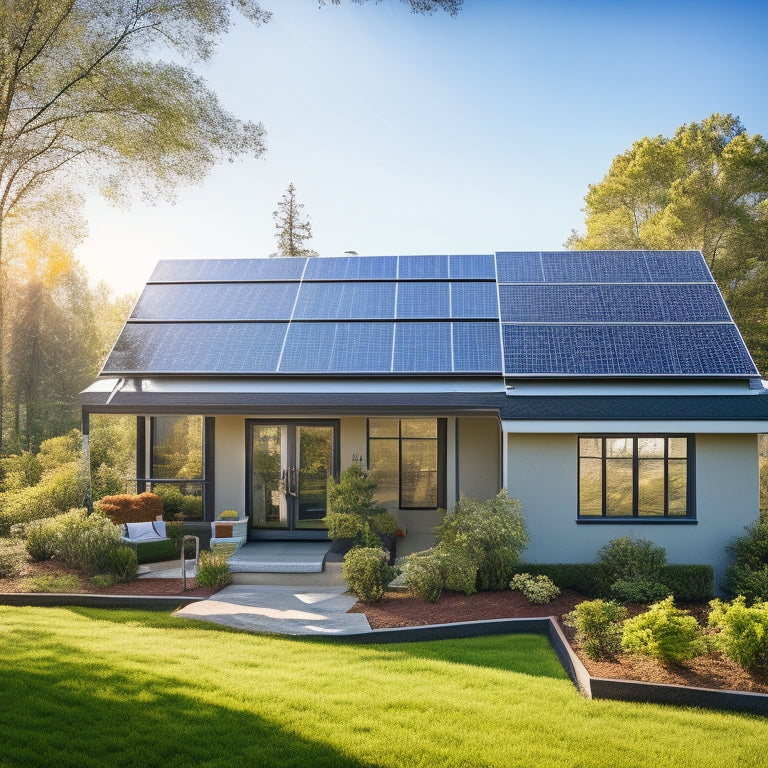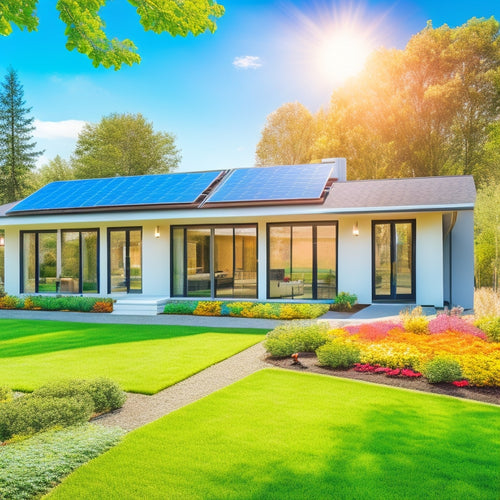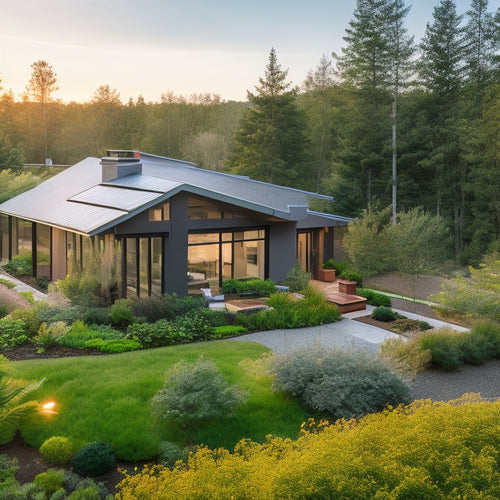
Installing a Solar System for a Residential House in 5 Steps
Share
You're about to initiate a 5-step expedition to convert your residential house into a solar-powered haven. First, assess your home's solar potential by evaluating sunlight exposure, conducting a solar site evaluation, and performing a shading analysis. Next, choose the right solar panels based on your energy needs, budget, and roof space. Then, plan the installation process, including evaluating your roof's condition, researching permits, and exploring financing options. After that, install the solar system, comprising mounting systems, solar panels, inverters, and monitoring systems. Finally, connect to the grid by installing a grid tie inverter and net meter, and get ready to reveal the full potential of your solar system.
Key Takeaways
- Assess your home's solar potential by evaluating sunlight exposure, conducting a site evaluation, and performing a shading analysis.
- Choose the right solar panels based on your energy needs, budget, and roof space, considering monocrystalline, polycrystalline, and thin-film options.
- Plan the installation process by evaluating your roof's condition, obtaining necessary permits, and creating a detailed project timeline and budget.
- Install the solar system, including the mounting system, solar panels, inverter, and monitoring system, to convert sunlight into electricity.
- Connect to the grid by installing a grid tie inverter and net meter to measure energy production and consumption, and receive utility credits for excess energy.
Assessing Your Home's Solar Potential
Before installing a solar system, evaluate your home's solar potential by analyzing its exposure to sunlight. This is essential to determine if your house is a good candidate for solar power.
Conduct a solar site evaluation to identify the best location for your solar panels. This involves examining your roof's orientation, slope, and size.
You'll also need to perform a shading analysis to identify any obstructions that may block sunlight from reaching your solar panels. Check for trees, buildings, and other structures that could cast a shadow on your roof.
You can use online tools or consult with a professional to conduct a thorough evaluation. Once you've gathered this information, you'll be able to determine the ideal location and size of your solar system.
This will guarantee you maximize your energy production and get the most out of your investment. By accurately evaluating your home's solar potential, you'll be one step closer to utilizing the power of the sun.
Choosing the Right Solar Panels
With your home's solar potential assessed, you're ready to select the ideal solar panels for your system. Choosing the right solar panels is vital to maximize energy efficiency and reduce your carbon footprint. There are three main solar panel types to take into account: monocrystalline, polycrystalline, and thin-film.
| Solar Panel Type | Energy Efficiency | Cost |
|---|---|---|
| Monocrystalline | 15-20% | High |
| Polycrystalline | 12-15% | Medium |
| Thin-film | 7-14% | Low |
Monocrystalline solar panels offer the highest energy efficiency but come at a higher cost. Polycrystalline solar panels provide a balance between efficiency and cost. Thin-film solar panels are the most budget-friendly option but have lower energy efficiency.
Think about your energy needs, budget, and available roof space when selecting the right solar panels for your system. It's important to choose panels that meet your energy requirements while fitting within your budget.
Planning the Installation Process
Now that you've selected the ideal solar panels for your system, it's time to plan the installation process. This step is vital to guarantee a smooth and successful installation.
Start by evaluating your roof's condition and determining the best installation layout. You'll need to take into account factors like roof size, orientation, and shading to maximize energy production.
Next, research local permitting requirements and obtain necessary permits before commencing the installation. This may include electrical and building permits, as well as compliance with local zoning laws.
Additionally, investigate financing options to fund your solar system. You may be eligible for government incentives, tax credits, or special loan programs.
Create a detailed project timeline and budget to keep your installation on track.
Installing the Solar System
Your solar panel system's installation is a complex process that requires attention to detail and precise execution. It's essential to guarantee that your system is installed correctly to maximize energy production and minimize maintenance costs.
The installation process can be broken down into several key components:
| Component | Description | Installation Cost |
|---|---|---|
| Mounting System | Secures solar panels to your roof | $1,500 - $2,500 |
| Solar Panels | Converts sunlight into electricity | $10,000 - $15,000 |
| Inverter | Converts DC power to AC power | $2,000 - $3,000 |
| Monitoring System | Tracks system performance and energy production | $500 - $1,000 |
Keep in mind that installation costs can vary depending on the size and complexity of your system. However, with federal and state solar incentives, you can considerably reduce your upfront costs. Be sure to research and take advantage of these incentives to maximize your return on investment.
Connecting to the Grid
Connecting your solar panel system to the grid allows you to sell excess energy back to the utility company and offset your electricity bills.
To do this, you'll need to install a grid tie inverter, which converts the DC power from your solar panels into AC power that matches the grid's frequency and voltage. This inverter will also monitor the grid's voltage and frequency, ensuring a safe and efficient connection.
Next, you'll need to install a net meter, which measures the energy you produce and consume.
This meter will spin backwards when you're producing more energy than you're using, and forwards when you're using more energy than you're producing. The utility company will provide this meter and install it at your location.
Frequently Asked Questions
Can I Install Solar Panels on a Metal or Clay Tile Roof?
You'll need to contemplate specific installation considerations for metal or clay tile roofs, ensuring a secure and watertight fit; for metal roofs, you'll use specialized clamps, while clay tiles require careful removal and replacement to accommodate solar panels.
How Long Does a Typical Solar Panel Warranty Last?
You're wise to wonder about warranty duration; a typical solar panel warranty lasts around 25 years, covering defects and performance, giving you peace of mind, like having a reliable backup plan, ensuring your investment shines bright for decades to come.
Are Solar Panels Affected by Shade From Nearby Trees?
You'll notice that solar panels affected by shade from nearby trees can greatly reduce solar panel efficiency. To optimize energy output, you'll want to think about tree trimming or relocation to minimize shade, ensuring maximum energy production.
Can I Monitor My Solar System's Energy Production Remotely?
You can track your solar system's energy production remotely through a monitoring platform, allowing you to view real-time energy tracking data, receive alerts, and optimize your system's performance from the comfort of your own home or on-the-go.
Do Solar Panels Require Regular Maintenance or Cleaning?
You're like a captain checking your ship's sails - you want to guarantee your solar panels are running efficiently. Yes, you'll need to clean them regularly to maintain peak panel efficiency; schedule maintenance every 6-12 months to keep energy production sailing smoothly.
Conclusion
As you flip the switch, your solar system roars to life, utilizing the sun's energy like a wild mustang finally set free. The expedition was long, but the payoff is worth it - you've tamed the beast of electricity bills and ridden off into a sustainable future. With each kilowatt-hour generated, you're writing a new chapter in your home's story, one of independence and eco-friendliness. Congratulations, you've successfully installed a solar system and released a brighter tomorrow.
Related Posts
-
Trends in Renewable Energy Storage Technologies
You're witnessing rapid advancements in renewable energy storage technologies aimed at improving efficiency and scala...
-

How Solar Panels Increase Property Value
Installing solar panels considerably increases your property value by improving energy efficiency and attracting eco-...
-

Sustainable Home Design for Reduced Carbon Footprint
Sustainable home design is your pathway to a smaller carbon footprint and a healthier living space. By incorporating ...

